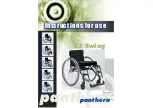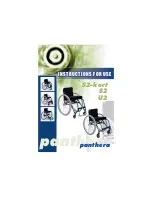
31
30
26
26.1
3.3.4.8 Adjustment of foot plate
height
Depending on the model and version,
the height of the foot plate is adjusted
as follows:
a) After removing the locking screw (Fig.
24/
➀
) adjust the foot plate telescop-
ically to the desired height. Observe
markings indicating maximum exten-
sion. Re-tighten locking screw.
b) After loosening the screwed connec-
tion (Fig. 25/
➀
) adjust the foot plate
telescopically to the desired height.
Re-tighten screwed connection.
3.3.4.9 Foot board
The foot board can be folded up (Fig.
26).
When folding it down, ensure that the
lateral guide (Fig. 26.1/
➀
) is supported
on the locking pin (Fig. 26.1/
➁
).
If folding up to the other side is required,
the foot board can be pulled out after
loosening the screwed connections (Fig.
24/
➁
), turned round and re-installed.
Re-tighten screwed connections.
Loosening the locking screws (Fig. 27/
➂
) allows variable adjustment of depth
positioning. To adjust the angle, loosen
the locking screw (Fig. 27/
➁
) and pull
out the teeth and set the angle of the
foot board. Re-tighten screw.
1
2
3
2
2
25
1
27
24
23
3.3.4.6 Positioning of foot plates
To set the foot plate position, the lock-
ing screws (Fig. 23/
➀
)must first be re-
moved. Re-tighten screws.
When the screwed connections have
been loosened (Fig. 23/
➀
) the position
of the foot plate can be adjusted by 1.5
cm either forwards or backwards. Re-
tighten screwed connections.
3.3.4.7 Adjustment of foot plate
angle
After removing the locking screw (Fig.
24/
➁
) pull out the teeth and set the
angle of the foot plate. Re-tighten screw.
The regulating screw (Fig. 24/3) is used
to correct the angle of the foot plate in
a crosswise direction.
1
















































